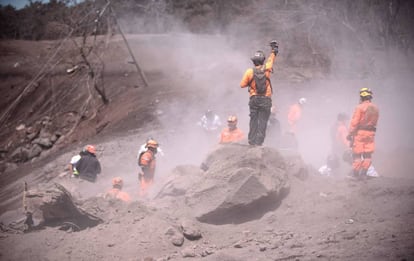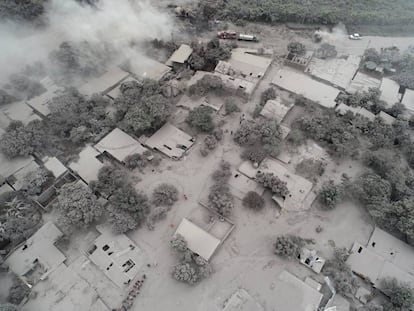Panic at the foot of a Guatemala volcano
The eruption of the Volcán del Fuego on Sunday has left 99 dead and almost 200 missing


All disasters follow similar patterns: first comes chaos and destruction, then tears as the level of destruction is revealed, and finally silence and fear when the lights go out. It is then that survivors look back with harrowing memories of those who weren’t so lucky.
Recent estimates place the number of casualties from the Sunday eruption of the Fuego volcano at 99, with 200 missing. An additional 3,000 people have been injured and evacuated, all adding up to one of the largest tragedies in recent history for Guatemala, a country with 38 volcanoes.
Faced with the hazardous and difficult task of searching for more survivors and the risk of further eruptions, local authorities are evaluating the possibility of ending the rescue efforts and turning the area into a cemetery.
There are 3,000 wounded and evacuated victims, resulting in one of the largest tragedies in recent history for Guatemala
Meanwhile, on the fringes of the volcano, residents of San Miguel Los Lotes, a village entombed by the pyroclastic flow, continue to wander around ground zero. They walk through a lunar landscape where their homes have been covered by tons of ash and silence. Simultaneously, rescuers are racing against the clock in search of life signs on the roofs of houses that only last Sunday stood two floors above the ground. The air is unbreathable without a mask, the ground is still burning hot, and in a few seconds one is covered in layers of dust and ash.
Gladys is one of the people who recently arrived at the foot of the volcano, where she identified her son by a shoe on the ashes. Áxel was fortunate enough to have escaped with his three children and is now desperately looking for his remaining 12 family members, while Felino Coronado walks around like a zombie, searching for his son because “my heart tells me he is still alive.” With a lost look in her eyes, Griselda Martinez awaits at the base of the 3,700-meter high volcano, sitting on a bag of clothes before returning to the shelter where she has been sleeping since Sunday.
That morning she had gone to San Miguel Los Lotes to visit her sisters as part of their routine Sunday family lunch. However, everything seemed strange that morning: noises were coming out of the earth, and the animals seemed nervous. An hour later the sky darkened, the temperature rose, and it became harder to breathe. At 3pm the volcano exploded violently, and Griselda began to run as a river of gas, boiling water and rock flowed down the mountain side, engulfing every house in its path.
“We escaped as fast as we could, we did not have time to grab anything, we focused on saving our lives,” she describes as she stares at the horizon. This horizon is occupied by three volcanoes that surround the village: the Volcán de Agua, the Acatengango, and the devastating Volcán de Fuego. Her brother-in-law was left behind along with her four-year-old niece who was unable to escape in time. On the table, the plates and silverware remained where they had been placed, ready for the meal that never came.
Fear and rumors of more explosions from the volcano dominate the minds of the survivors
Adding to the survivors’ sorrow is the fear of more explosions from the volcano. On Tuesday afternoon the population of Escuintla entered into panic mode when they learned of a lahar flowing down the mountain. This river of mud and debris, which poses even greater danger than lava, flowed down the riverbed, stopping just short of the city.
The announcement from the Volcanic Institute increased the panic. It warned that “the activity [of the Volcano] continues” and indicated the possibility of “additional pyroclastic flows in any of the neighboring hillsides in the following hours or days. Furthermore, due to the presence of rain in the volcanic area, we can expect further lahars to flow.”
“I saw it on the news,” “My friend told me,” “I saw it on my phone” or “They told my son,” said most of the fleeing people. Very few had actually been warned directly by the National Coordination for Disaster Reduction to evacuate the city.
In the meantime, undertakers and evangelical pastors were making the rounds of the morgue and the shelters. Some people thought that the apocalypse had truly arrived when the sky went dark again and a thunderstorm began beating down on the city.
English Version by Andres Cayuela.
Tu suscripción se está usando en otro dispositivo
¿Quieres añadir otro usuario a tu suscripción?
Si continúas leyendo en este dispositivo, no se podrá leer en el otro.
FlechaTu suscripción se está usando en otro dispositivo y solo puedes acceder a EL PAÍS desde un dispositivo a la vez.
Si quieres compartir tu cuenta, cambia tu suscripción a la modalidad Premium, así podrás añadir otro usuario. Cada uno accederá con su propia cuenta de email, lo que os permitirá personalizar vuestra experiencia en EL PAÍS.
¿Tienes una suscripción de empresa? Accede aquí para contratar más cuentas.
En el caso de no saber quién está usando tu cuenta, te recomendamos cambiar tu contraseña aquí.
Si decides continuar compartiendo tu cuenta, este mensaje se mostrará en tu dispositivo y en el de la otra persona que está usando tu cuenta de forma indefinida, afectando a tu experiencia de lectura. Puedes consultar aquí los términos y condiciones de la suscripción digital.
More information

Guatemala: A volcano erupts and a city is gripped by panic

Fuego volcano survivor: “The lava was on top of us”
Archived In
Últimas noticias
Most viewed
- Alain Aspect, Nobel laureate in physics: ‘Einstein was so smart that he would have had to recognize quantum entanglement’
- David King, chemist: ‘There are scientists studying how to cool the planet; nobody should stop these experiments from happening’
- Maps of the US attack on Venezuela: Targets, airspace and deployed fleet
- Key points of the military attack on Venezuela: Early morning bombings and a ‘captured’ president
- Trump says Washington will control Venezuela until there is ‘a safe transition’








































